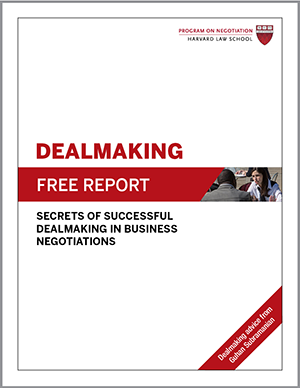
In negotiation, some justifications are more persuasive than others, research suggests. And learning how to counter offer in the right way can make significant differences in outcomes. For example, imagine that you are a café owner who is soliciting quotes for a redesign of your space. One of the interior designers you’ve been talking to is known for being affordable, if not innovative. But the designer’s initial estimate, $20,000, is well over your $16,000 budget for the project and, you believe, excessive. As you prepare to make a counteroffer, you aren’t sure whether to emphasize your own cost constraints or to cite what you perceive as the designer’s rather middlebrow reputation in your argument for a lower price.
When preparing to negotiate price, buyers and sellers have access to plenty of advice about whether to make the first offer and, if they do, what price to choose. Making the first offer is often a smart move, especially if you have a strong sense of the value of the item or service being sold. The first offer often anchors the discussion that follows and, as such, can have a powerful effect on the final outcome.
But what if the other side makes the first offer, whether because of convention, because you weren’t sure what to offer, or because they simply spoke up first? In such cases, you’ll need to be prepared to know how to counter with a strong rationale—one that not only resists the other party’s anchor but also makes a compelling case for the price you name.
When you present a persuasive rationale, you may increase your odds of reanchoring the discussion and avoiding impasse. But what types of rationales will help you reach your goals?
In a new study in the journal Organizational Behavior and Human Decision Processes, researchers Alice J. Lee, Assistant Professor of Organizational Behavior in the ILR School at Cornell University and Daniel R. Ames of Columbia University compared the effectiveness of two common types of rationales that buyers use when responding to a seller’s opening bid. We’ll consider how negotiators can benefit from these insights and present other tips for framing price offers in negotiation.
How to counter offer with constraints and complaints
Buyers can supply many types of rationales for their counteroffers. In their study, Lee and Ames focus on two of the most common rationales that buyers use: (1) constraint rationales and (2) disparagement rationales.
A constraint rationale focuses on the buyer’s own limitations, which are typically financial. Returning to our opening scenario, for example, the café owner might respond to the designer’s opening bid of $20,000 by saying, “That’s way over my budget and won’t work for me.”
By contrast, a disparagement rationale critiques what the seller is offering. For example, the café owner might say to the designer, “My understanding is that your services are pretty no-frills. Given what you’re offering, your price seems much too high.”
Both types of rationales appear to be very common in negotiation, Lee and Ames found when they videotaped pairs of MBA students engaging in a role-play negotiation as buyer and seller. About 90% of those in the role of buyer used constraint rationales, delivering two such rationales per negotiation, on average. And 95% of buyers used disparagement rationales—about five times, on average, per negotiation.
How to counter offer with a winning rationale
Which of these two types of rationale from the café owner do you think the designer would find more persuasive? In several experiments, Lee and Ames compared the effectiveness of constraint and disparagement rationales in various scenarios to determine how to counter offer most successfully.
In one experiment, the researchers asked participants to imagine they were participating in an online negotiation similar to the one we’ve described between a café owner and a potential designer. In the first phase of the experiment, those in the role of the café owner (the buyer) were told that the designer (the seller) submitted an initial estimate of $20,000 for the work. Some buyers were encouraged to focus on their budgetary constraints when responding with a counteroffer (constraint-rationale condition); others were prompted to focus on the mixed quality of the designer’s past work (disparagement rationale condition); while those in the control group were not given any special guidance.
In the next phase, all the participants assigned to the role of the designer (the seller) were told that the café owner had counteroffered $16,000. They also received the rationale formulated by their partner. Next, they responded to the $16,000 counteroffer and rationale with a counteroffer of their own.
The results? Sellers were significantly more swayed by constraint rationales than by disparagement rationales. Specifically, when offered $16,000 with a constraint rationale, sellers (those in the role of designer) responded with an average counteroffer of $17,059. But when offered $16,000 with a disparagement rationale, sellers’ average counteroffer was $18,375. In other words, when buyers justified a low counteroffer based on their own financial constraints, sellers conceded significantly more on price than when buyers disparaged sellers’ services to justify the same low counteroffer.
Sellers may view criticism as inaccurate and rude, and react by standing firm on price.
Relative to those who received disparagement rationales, sellers who were given constraint rationales also were more optimistic about the odds of reaching agreement and were more likely to recommend their counterpart to a friend. In other experiments, Lee and Ames found a similar pattern of results.
Why disparagement falls flat
There are two main reasons why providing information about your constraints is likely to be more effective than disparaging the seller’s products or services. First, and most obviously, sellers may view the criticism as inaccurate and rude, and react by standing firm on price. Second, when buyers describe their financial constraints, they are revealing valuable information about their bottom lines. Sellers may take buyers at their word when they say they simply can’t afford the deal on the table.
Constraint rationales are more effective than disparagement rationales when sellers know the value of what they’re selling. When a designer believes he is offering a competitive price for his services, for example, he may dismiss the café owner’s critique as merely a bargaining tactic. By contrast, when sellers are uncertain about the value of what they’re selling (such as a new product), they may take a buyer’s criticism to heart and offer a better price, Lee and Ames found in another experiment. Thus, this is one situation in which disparagement rationales may be relatively effective—but no more effective than citing your financial constraints.
Overall, the research offers valuable advice to buyers: When deciding how to counter offer a seller’s initial price, you are likely to get a better deal if you accompany your counteroffer with information about your financial constraints than if you try to diminish the value of what’s being sold.
3 other effective influence strategies
Here are some other influence strategies to use to improve the appeal of your price offers:
1. Highlight losses rather than gains.
People are more motivated to avoid losses than they are to achieve gains, research by the influential psychologists Amos Tversky and Daniel Kahneman shows. For example, in one study by researchers at the University of Santa Cruz, homeowners were asked to participate in a free energy audit and then listen to a sales pitch for insulation products and services that would lower their energy costs. When the insulation was pitched as a way to avoid losing money, homeowners were significantly more likely to purchase it than when it was pitched as a way to save money. Because losses weigh heavily on our minds, framing the exact same price as a loss likely will have a greater effect than framing it as a gain, write Deepak Malhotra and Max H. Bazerman in their book Negotiation Genius (Bantam, 2007).
2. Split up losses; combine gains.
Tversky and Kahneman also discovered in their research that people prefer to gain money in installments but to lose money in one lump sum. For example, most people would prefer to find a $10 bill two days in a row ($20 total) than to find a $20 bill once. Conversely, most people would prefer to lose a $20 bill than to lose a $10 bill two days in a row. Thus, when making a price concession, it can be smart to divide it into two or more smaller concessions. But when asking for a concession on price, make one demand rather than two or more partial demands, recommend Malhotra and Bazerman.
3. Avoid overjustifying.
A well-known 1978 psychology experiment by Ellen Langer, Arthur Blank, and Benzion Chanowitz suggested that even a lame justification for a first offer can be more effective than no justification at all. In the study, an experimenter who tried to cut in line to use a copier to make five copies was far more successful using the rather weak justification “May I use the Xerox machine, because I have to make some copies?” than when giving no justification at all for cutting in (“May I use the Xerox machine?”).
But in a 2011 paper, Tel Aviv University researchers Yossi Maaravi, Yoav Ganzach, and Asya Pazy noted that people tend to rebel against more significant requests with weak justifications. And in their research, they found that when a justification for an offer is easy to counter, it can inspire a backlash. So, for example, if you are a salesperson who has already shown off the many attractive features of your product, you can let your first price offer stand on its own.
What has your experience been in determining how to counter offer an initial price anchor?




